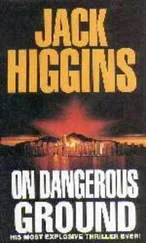“What do you think it is, Mr. Mitchell?” Holtzmann asked.
The bearing rate was the key. The only thing that moved that fast was an aircraft and the only aircraft in this neck of the woods were Russian ASW planes. “A Bear or May patrol aircraft.” He tried to sound confident. “It’s close, too.”
As if on cue, the loudspeaker squawked back to life. “Conn, sonar. Sierra seven six now bears three one five degrees, drawing rapidly to the right. Contact is classified as a Bear Foxtrot.”
“Good guess, sir. Now tell me how they know it’s a Bear?” Holtzmann inquired as he reached up and changed the display to one that showed narrowband data.
Jerry smiled as he admitted his ignorance. “I know it has something to do with the type of engines, but other than that Ihaven’t a clue of what I’m looking at here.”
Narrowband sensors look for acoustic noise sources that are tightly confined within a very small frequency range. This kind of noise is produced by machinery that operates in a very regular and repetitive manner — like an aircraft’s engines. Both the Tupolev Bear and the Ilyushin May are driven by four large turboprop engines, but the Bear has huge contra-rotating props on each one. The extra set of blades showed up clearly on the display.
“See these four groups of doublets,” Tom said as he pointed to the close lines on the display. “That signal is the sound of his propellers. Each set of contra-rotating blades generates two frequencies that are really close to each other. Only a Tu-142 Bear Foxtrot has that kind of signature. And if we can hear the sound of his props, then he’s close. What should we do?”
Both planes were armed with ASW torpedoes, although there was no risk of attack this far away from Russian territorial waters. A greater danger was posed by the planes’ suite of ASW sensors. They carried radar, an ESM sensor that could detect other radars, and a short-range magnetic sensor called MAD that could sense the thousands of tons of steel in Memphis’ hull. They also carried dozens of sonobuoys that could be dropped in patterns designed to detect a sub — if the plane’s crew thought there was cause to use them.
Had this plane detected them? Were they responding to a report of a Yankee nuke approaching their waters? Or were they on their way home after a training mission? If Memphis was detected, or if the Russians even suspected there was a U.S. sub in the area, they would flood the area with ships and aircraft.
“Set up a track, and rig for ultra-quiet,” Jerry recommended.
“Should we change depth?” Holtzmann asked.
Jerry thought for a beat, then said honestly, “I don’t know.” Working it though, he reasoned, “If we go deep, we could get a little farther away from his MAD sensor, but if he drops sonobuoys, he’ll put them on both sides of the layer, and we won’t be able to hear him as clearly on the far side of the layer.”
The “layer,” or thermocline, was a sudden change in the temperature of the seawater that partially reflected sound waves. The depth of the layer varied from day to day, but sub sailors always made it their business to know where it was, and to use it to their advantage. Putting the layer between a sonar and the sub was like hiding in the shadows. It didn’t make you invisible, but it did make you harder to spot.
He paused, then said, “I recommend staying at this depth.”
Holtzmann nodded, “Do it.”
Jerry stepped back to the center of the control room. “Helm, all ahead one-third, make turns for five knots. Rig ship for ultra-quiet.” He turned to Holtzmann. “Should we notify the Captain?” As he asked his question, he heard his order echoed over the IMC: “Rig ship for ultra-quiet.”
“We’d be in big trouble if we didn’t,” replied the ensign. He picked up the phone and dialed a number. “Captain, Officer of the Deck. Sir, sonar’s detected a Bear Foxtrot off our port side, drawing rapidly to the right, evaluated as close. We’ve reducing speed and rigging for ultra-quiet.” He paused for a moment, then answered, “Yessir.”
Hardy stepped into the control room moments later. He stopped at the chart table for a moment, then studied the Bear’s track on the fire-control system. Silently, he headed toward the sonar displays as the watch team scrambled out of the way.
The waterfall display now showed about five minutes of track history, a single fuzzy line angling to the right, straight and steady. The Russian was continuing on his way
The Captain returned to the plot table, then the sonar display. He started to speak but caught himself before saying anything. Finally the petty officer manning the fire-control position said, “Contact is past closest point of approach and opening.”
He spoke softly — not a whisper, but not a normal speaking voice either. Jerry noticed that the control room suddenly seemed quieter. He realized that many of the familiar machinery noises were missing from the background. He also felt the boat slowing, a subtle difference in the deck’s vibration.
Hardy also spoke softly. He ordered, “Maintain this speed for thirty minutes after contact is lost, then resume normal speed and secure from ultra-quiet.”
“Aye, aye, sir,” Holtzmann acknowledged.
Hardy left, but a minute later the two ladies entered, almost breathless. “What’s ‘ultra-quiet’ mean?” demanded Patterson. “What’s happening?” asked Davis. Concern filled both their faces. Their voices, also full of concern, were raised and sounded harsh in the quiet control room. A soft chorus of “Quiet, please” and “Speak softly” surrounded them. Even Patterson looked embarrassed as the two were hushed.
“It’s just a precaution,” assured Holtzmann. “Sonar picked up a Russian patrol plane and we went quiet to make sure it didn’t pick us up.”
“You mean it almost found us?” Concern grew to alarm on Patterson’s face. She started to speak softly, then forgot as emotion filled her voice.
“No, ma’am, there’s no sign of that. It passed close enough for us to hear it, but there’s no indication it changed course or did anything but continue flying from point A to point B. It’s headed away from us now, but just to be on the safe side, we’ll lay here in the weeds for a while, just in case he did drop a sonobuoy or three.”
“And they can hear us if we speak too loudly?” Emily’s question was a mixture of curiosity and surprise.
“Ma’am, at ultra-quiet, we reduce speed to a creep. This not only reduces the flow noise as the boat’s hull passes through the water, it also lets the engineers shut down some of the machinery. Unnecessary equipment, like some of the ventilation fans, are turned off, and some normal activities, like cooking in the galley, also stop. And all off-watch personnel are supposed to get into their racks and stay there.”
“Like us?” Emily asked.
Holtzmann nodded. “Like you two ladies.”
“And they can really hear us walking around and talking?” Patterson asked.
“It isn’t that the walking and talking are all that noisy.” Holtzmann explained. “It’s that everything else is that quiet. The whir of a fan, the sound of pans clattering in the galley, or a loud conversation may be the first thing they pick up.”
The XO had come in during Holtzmann’s explanation. He checked the fire-control track and the chart, then turned toward the ladies. “This is the part where we lie on our bellies in the mud while searchlights pass overhead. This is where we paint our faces green and merge with the underbrush. If they find us on the way in, it’s going to be harder — a lot harder — for us to get the job done.
“It’s not like it was back in the ‘70s and ‘80s, when we had a huge acoustic advantage,” he continued, “and we are heading straight for the Russian Navy’s front yard. Not only is their Northern Fleet headquarters here, but half a dozen sub and surface ship bases and as many air bases. In other words, the entire Northern Feet’s right over there.” He pointed to the southeast.
Читать дальше












